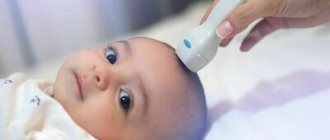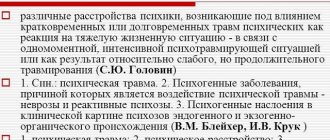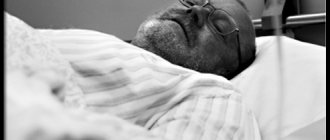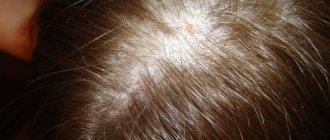Psychogenic breathing disorders can occur even in a state of physical rest, in various body positions and in the absence of organic diseases of the lungs, heart, and blood vessels, which is the main difference between psychogenic shortness of breath and respiratory pathology in somatic diseases of the organs. Otherwise, the symptoms of respiratory disorders in psychosomatics are similar to the signs of such disorders in general diseases.
Dyspnea of psychogenic etiology is characteristic of hysterical states, panic disorders, somatoform dysfunctions of the autonomic nervous system, psychosomatic pathologies, astheno-depressive syndrome.
The NEARMEDIC network of clinics offers a full cycle of high-precision diagnosis and treatment of psychogenic shortness of breath using modern psychotherapeutic techniques and minimal use of drug therapy.
Symptoms of psychogenic dyspnea
As with breathing disorders of various etiologies, psychogenic shortness of breath is characterized by changes in the frequency, rhythm and depth of breathing. More than 80% of patients with psychogenic disorders complain of:
- decrease or increase in the number of inhalations and exhalations;
- inhalation dissatisfaction;
- feeling of constriction of the chest;
- awareness of the breathing process, control over it;
- feeling of lack of air;
- a feeling of air being “stuck” in the trachea, a lump in the throat;
- neurotic cough (dry, persistent);
- neurotic yawning;
- reflex hyperventilation due to dissatisfaction with inhalation;
- pain in the intercostal muscles;
- forced movements to expand the chest (straightening the shoulders, moving the arms, body, changing body position), which do not lead to the expected result;
- increased anxiety, depressed mood, fear of death from suffocation.
Since neurotic breathing is shallow, with shortened inhalation and prolonged exhalation, breathing difficulties cause a natural desire to take a deeper breath, which leads to hyperventilation and an aggravation of the process with the appearance of false angina and/or the development of cardioneurosis, attacks of neurotic asthma. Patients complain of dizziness, increased sweating, dry mouth, weakness, cold hands and feet, and limb cramps. Neurotic pseudoasthmatic attacks may be accompanied by changes in breathing sounds - the appearance of whistling, groaning.
A distinctive feature of psychogenic shortness of breath can be the cyclical nature of the pathology, which depends on weather conditions (high humidity, low atmospheric pressure) and seasonal exacerbation of the existing psychogenic disorder.
In the absence of somatic diseases, such symptoms are a reason to seek psychotherapeutic help as soon as possible, since further development of psychogenic shortness of breath can lead to the appearance or exacerbation of hypochondria, hysterical disorders, general cardiovascular and pulmonary diseases.
Self-medication is dangerous because psychogenic shortness of breath is treated only in conjunction with the underlying disease of which it is a manifestation. Clear differentiation from other pathologies is possible only on the basis of laboratory and hardware examinations, the scope of which can only be determined by a highly qualified psychotherapist or psychiatrist.
Acute mental disorder - treatment
Reactive psychoses require immediate isolation from a traumatic environment and hospitalization. Neurotic spectrum disorders in mild cases are treated on an outpatient basis.
For reactive (psychogenic) paranoid, antipsychotic therapy is preferably not recommended. It is necessary to prescribe sedatives, although they are not etiotropic therapy. It is necessary for the patient to get a good night's sleep.
For psychogenic depression, antidepressants are prescribed if the severity of the depressive state is significant and psychotherapy does not help the patient feel comfortable. For severe anxiety, anxiolytics and tranquilizers are used, and sleeping pills are used to normalize sleep.
The most important place in the treatment of psychogenic disorders is occupied by psychotherapeutic work with the patient at different stages of treatment.
We constantly detect plagiarism on our materials without providing a clickable follow link to them. In this case, without warning, we turn to Google DMCA , which leads to pessimization of the plagiarist. On the contrary, we welcome the popularization of our materials, but with the obligatory active follow link to this page psyhosoma.com/psixogennye-rasstrojstva-reaktivnye-reakcii-cheloveka-na-tyazhelye-zhiznennye-obstoyatelstva/ .
Differentiation from common diseases
Psychotherapists of the highest and first categories who receive treatment in the psychotherapy departments of the NEARMEDIC network of clinics can differentiate psychogenic shortness of breath from disorders of respiratory function caused by diseases of the heart, blood vessels, lungs and other organs when collecting an anamnesis during a detailed conversation with the patient.
Externally, such patients do not show any manifestations of dysfunction of the respiratory organs or heart function - there is no specific coloring of the skin (cyanosis), the patient is hyperactive. When attention is diverted from problems with the respiratory process during a conversation, breathing disorders are smoothed out until they disappear completely and appear if the doctor returns to discussing these problems.
The doctor pays attention to the rhythm of the disturbances - with psychogenic shortness of breath it is uneven, unstable, the intensity and depth of breathing can be variable with each inhalation and exhalation.
An important point is to identify the connection between the occurrence of respiratory dysfunction and body position. Dyspnea - a feeling of lack of air, characteristic of psychogenic shortness of breath, is also inherent in the general disease. But with pathologies caused by psychogenia, there is no connection between body position and the severity of the attack, as is observed with orthopnea (shortness of breath that occurs in a lying position), trepopnea (in a side position), platypnea (in a sitting position). Orthopnea is most often a sign of cardiovascular or pulmonary pathology, trepopnea is a sign of heart disease, and platypnea is usually found in congestive heart failure.
Psychogenic shortness of breath is characterized by periodicity, associated not only with seasonality and weather conditions, but also with the time of day: for each patient these are different periods - both morning and evening hours. Night attacks cause sleep disorders, insomnia associated with fear of suffocation and death in sleep. In turn, such fears cause an exacerbation of mental pathology with disturbances in the rhythm and depth of breathing.
If the pathology is accompanied by a neurotic cough, then it cannot be treated with medications.
During the initial physical examination, the doctor may check your breathing rate, listen to your lungs, and evaluate your heart sounds using a phonendoscope. If cardiac or pulmonary diseases are suspected or if at the time of examination it is known that the patient has such pathologies, the psychotherapist refers him to a consultation with a cardiologist or pulmonologist.
Consultation with an allergist and special tests will help differentiate breathing problems caused by allergic agents.
To clarify the primary diagnosis, the following laboratory and hardware diagnostic methods can be prescribed in the NEARMEDIC network clinic:
- general blood test and study of its gas composition;
- allergy tests;
- spirometry;
- radiography;
- CT scan;
- MRI;
- Ultrasound of the heart;
- ECG;
- Echo-KG.
The NEARMEDIC diagnostic laboratory has all the necessary equipment from the world's best manufacturers of medical equipment. MRI and ultrasound doctors, laboratory technicians use the most modern diagnostic and differentiation techniques. This makes it possible to establish a diagnosis with high accuracy, which contributes to effective psychomedicinal therapy.
Hysterical (dissociative) psychoses are represented by psychotic states that are heterogeneous in clinical picture - hysterical twilight stupefaction, pseudodementia, puerilism, delusional fantasy syndrome, personality regression syndrome, hysterical stupor. Depending on the severity and duration of the reaction in the picture of psychosis, either a combination of various hysterical disorders or a consistent transformation of some hysterical manifestations into others is observed. This type of psychogenic reactions in peacetime is most often observed in forensic psychiatric practice (“prison hysteria” - according to E. Kraepelin), but is also formed in connection with situations of loss (death of close relatives, breakup of marital relations), as well as some other pathogenic factors [Semke V. Ya., 1988]. In accordance with psychodynamic concepts, hysterical psychoses are interpreted as “repression reactions” of mental trauma.
Hysterical twilight stupefaction.
Reactive psychoses with twilight stupefaction, as well as affective-shock reactions, are often observed in military situations.
In forensic psychiatric practice, one of the variants of hysterical twilight stupefaction was described by S. Ganser in 1897 and was called Ganser syndrome.
According to the mechanism of occurrence and some clinical manifestations, such conditions are close to acute reactions to stress. However, unlike acute affective-shock psychoses, in hysterical twilight states there is no complete shutdown of higher cortical functions. Characterized by a narrowing of the field of consciousness, disorientation, deceptions of perception reflecting a traumatic situation, selective fragmentation of subsequent amnesia. The clinical picture of hysterical twilight states is distinguished by a mosaic of manifestations and demonstrative behavior of patients: laughter, singing and crying can be interrupted by a convulsive attack, freezing in a mournful pose is replaced by short-term excitement. Often there are abundant visual hallucinations and vivid figurative visions. Hysterical twilight disturbance of consciousness can sometimes last up to 1-2 weeks. The recovery from psychosis is gradual.
Pseudo-dementia
is
an imaginary, apparent dementia; the term was first introduced by C. Wernicke in 1906. Pseudo-dementia also occurs against the background of a narrowed consciousness and is characterized by an imaginary loss of simple knowledge, incorrect answers (mimorespeech) and actions (mimoactions). At the same time, patients goggle their eyes, smile foolishly, cannot perform simple arithmetic operations, are helpless when counting fingers, do not give their first and last names, are not sufficiently oriented in the situation, often white is called black, etc. The content of incorrect answers (in the words of patients with pseudodementia ) in contrast to the negativistic speech of catatonic people, is always associated with a traumatic situation. The answer in pseudodementia is often the exact opposite of what is expected (for example, “he is not in prison, he has bright prospects”). The same applies to passing actions (for example, in severe cases, patients put shoes on their hands, stick their legs into the sleeves of a shirt, etc.). Much less often, the phenomena of pseudodementia appear against the background of a deeper clouding of consciousness - with hysterical twilight disorders.
Puerilism.
This form of hysterical reaction is very close to pseudodementia syndrome and is often considered as its variety. The main thing in the picture of puerilism (the term was proposed by E. Dupre, 1903) is childishness, childishness of behavior against the background of a hysterically narrowed consciousness. The most common symptoms of puerilism are children's speech, motor skills and emotional reactions. Patients speak with childish intonations, lisp, run in small steps, build houses of cards, and play with dolls. Pouting their lips or stomping their feet, they ask to be held in your arms and promise to “behave well.” In contrast to the stereotypical foolishness of patients with schizophrenia with hebephrenic arousal, the symptoms of puerilism are much more diverse, changeable, with a bright emotional coloring of experiences. In addition, the symptoms of puerilism are usually combined with other hysterical manifestations.
For the hysterical syndrome of delusional fantasies,
first described by K. Birnbaum in 1908, are characterized by unstable ideas of greatness, wealth, and special significance that do not have a tendency to systematize. In a fantastically hyperbolic form, they reflect the desire of patients for rehabilitation and escape from a traumatic situation. For example, the patient says that he has been offered a high position, he is famous and famous, and is going to marry a popular actress. The content of such fantasies is very variable and largely depends on external factors (conversations of others, questions from the doctor, etc.). The syndrome of delusional fantasies can be replaced by phenomena of pseudodementia or puerilism, and with further deterioration of the condition - hysterical stupor.
Personality regression syndrome
[Buneev A. N., 1945; Felinskaya N.I., 1968] is characterized by the collapse of mental functions, accompanied by the loss of human behavior skills. Patients lose speech and self-care skills, move on all fours, eat with their hands, and cannot keep their clothes on.
Hysterical stupor
accompanied by pronounced psychomotor inhibition, mutism, and symptoms of clouding of consciousness (hysterically narrowed consciousness). The behavior of patients in this case reflects intense affect (suffering, despair, anger). According to the observations of N.I. Felinskaya (1968), the structure of the syndrome includes rudimentary symptoms characteristic of conditions (puerilism, pseudodementia, etc.) that preceded the formation of hysterical stupor.
A special place among hysterical psychoses is occupied by mental epidemics,
became widespread during the Middle Ages. Collective hysteria covered at that time about 2-8% of the residents of some cities. Epidemics of obsession with a varied picture of hysterical disorders (convulsive seizures, paralysis, hysterical hallucinations, etc.) were most often observed in nunneries and shelters. Among other forms of mass psychosis, hysterical dancing is mentioned, which had obvious features of ecstatic states that involved hundreds and even thousands of people [Yakubik A., 1982], as well as an epidemic of lycanthropy, manifested in hysterical attacks of barking and howling. Mental epidemics (hysteria, fussing, obsession with “hiccups”) occurred in the northern regions of Russia [Tokarsky A., 1893; Yakovenko V.I., 1911; Uryupina M.D., 1974; Medvedeva V.V., 1980].
There is an opinion that mental epidemics, the emergence of which was facilitated by illiteracy and superstition of the population, are a thing of the distant past. This optimistic approach seems insufficiently justified. Mental epidemics have not disappeared. At the end of the 20th century. they are as real as in the Middle Ages, but have changed in accordance with the new era. The “heroes” of the hysterical epidemics of the 90s are not only ufologists, Satanists, adherents of the occult and other owners of mystical experience, but also “specialists” in mass hypnosis, allegedly freeing the audience from various diseases, “charging” water and providing “health improvement” even through newspapers, as well as preachers of exotic diets, “healthy” lifestyles, etc., the concepts of which are multiplying uncontrollably and rapidly through the media, telecommunications and e-mail. The contagious mechanisms of the emergence of an epidemic of hysteria in our time are mediated by information circulating in books, newspaper and magazine articles, television programs, series and films shown on television or via the Internet.
Treatment of psychogenic dyspnea at NEARMEDIC
When treating respiratory dysfunction, psychotherapists use an integrated approach using psychotherapeutic, medicinal and physiotherapeutic techniques and measures. Whenever possible, our specialists strive to eliminate or limit drug therapy. A thorough knowledge of modern psychotherapy techniques allows them to successfully treat respiratory dysfunction caused by mental pathological conditions without the use of medications. For this purpose, both classical, traditional and innovative methods and techniques are used:
- classical psychoanalysis;
- Ericksonian hypnosis;
- integrative transactional analysis;
- cognitive behavioral psychotherapy;
- rational psychotherapy;
- Socratic dialogue techniques;
- Gestalt therapy;
- client-centered therapy by K. Rogers;
- body-oriented therapy;
- meditative breathing techniques.
For complicated forms of the underlying mental disorder, modern medications and a dosage regimen are prescribed that are precisely designed for the individual pharmacokinetics of each patient. When prescribing each drug (antidepressant, tranquilizer), not only the diagnosis is taken into account, but also the age, build, general condition of the patient, the presence of accompanying somatic diseases and other data.
A psychotherapist is the only specialist who can help you with psychogenic shortness of breath. A false prejudice against visiting doctors of this specialization can result in serious complications, including diseases of internal organs and systems. Psychotherapists from the NEARMEDIC network of clinics will not only restore your peace of mind, but also prevent the development of more severe disorders.
Classification of reactive states
Reactive states exist within the framework of neurosis and psychosis. In the first case, the patient remains critical of his condition. During psychosis, a person cannot control himself; he acts destructively and thoughtlessly, often under the influence of hallucinations and delusions.
The following forms of reactive psychoses exist:
- Acute reaction to a stressor (synonym – affective-shock reaction) – reactive psychosis
- Hysterical psychosis - hyperkinetic forms (hysterical excitement - Ganzer psychosis in jailers, during abduction), hypokinetic forms (mutism, stupor, pseudodementia).
- Psychogenic paranoid
- Psychogenic depression










